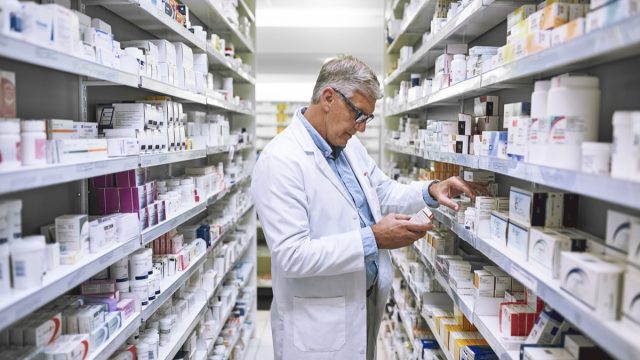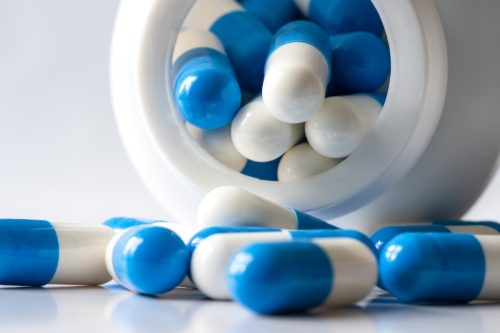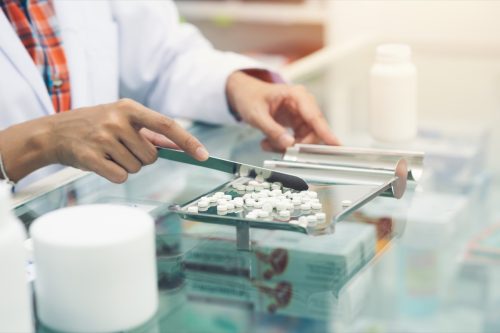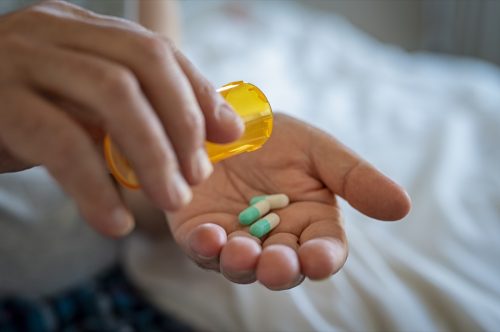Pharmacists Warn That All Antibiotics Are in Short Supply

Near the beginning of the pandemic, certain items, such as toilet paper and cleaning supplies, became difficult to find. But even now that restrictions have eased, supply issues continue: We’re currently dealing with major EMT staffing shortages, and many people with diabetes and ADHD are finding it difficult to access their medications. Those are not the only drugs experiencing a drought, however. An amoxicillin shortage has been impacting the U.S. for some time—and now pharmacists are warning that this is impacting other antibiotics. Read on to find out why all antibiotics are currently in short supply.
READ THIS NEXT: It’s Not Just Adderall—These Medications Are Also Facing Shortages Now.
The FDA first warned about an amoxicillin shortage last fall.

One antibiotic has been in short supply for some time now. Amoxicillin oral powder for suspension has been on the U.S. Food and Drug Administration’s (FDA) drug shortages list since Oct. 28. Amoxicillin is a penicillin antibiotic that treats bacterial infections and is only available with a doctor’s prescription, according to the Mayo Clinic.
But as the FDA explained in November alert about the amoxicillin shortage, this antibiotic is “widely used for the treatment of bacterial upper and lower respiratory infections in the pediatric population.” Last fall, the U.S. started struggling with a major early surge in respiratory syncytial virus (RSV) infections among children—and RSV often causes secondary bacterial infections, which pharmacists will prescribe amoxicillin to treat, per CBS.
Michael Ganio, the American Society of Health-System Pharmacists’ (ASHP) senior director for pharmacy practice and quality, told CNN that this high demand was creating a medication shortage unlike most others. “Generally, what we see in the drug shortages is on the production side. In this case, we don’t have any indication from the manufacturers that they’re having any sort of difficulty with production,” he explained. “”This one seems to be driven by demand, which is a little unusual. We see increased demand as a cause of a shortage fairly infrequently.”
Most pharmacists say this medication is still in short supply.

At the beginning of this year, the FDA said that amoxicillin could be hard to come by for months, and as of Feb. 15, the agency still has the antibiotic listed as “currently in shortage” on its drug shortages database. Most pharmacists also appear to corroborate this right now. On Feb. 15, pharmacy staffing agency Jackson Pharmacy Professionals released the results of its Pharmacists and Pharmacy Technicians on the Continuing Amoxicillin Shortage survey, which was given to 522 pharmacists and pharmacy technicians during the first two weeks of Feb. 2023.
According to the survey, 72 percent of pharmacists and pharmacy technicians reported observing an ongoing amoxicillin shortage in the last 45 days. “Our pharmacists have told us heart-wrenching story after story about parents being forced to trek to several different pharmacies in desperate search of amoxicillin for their sick children,” Bobbi Henson, president of Jackson Pharmacy Professionals, said in a statement.
RELATED: For more up-to-date information, sign up for our daily newsletter.
They also warn that this is not the only antibiotic experiencing a shortage now.

The ongoing amoxicillin shortage is creating problems for the U.S. in more ways than one. According to the Jackson Pharmacy Professionals survey, this shortage is now impacting the supply of other medications. One of the respondents explained that a dangerous domino effect is occurring. “Amoxicillin plays a vital role in healthcare… it’s the most commonly used antibiotic,” they said. “Due to this antibiotic shortage, it has created a chain reaction leading us to shortages of all antibiotics.
The American Academy of Pediatrics (AAP) issued guidance on alternative treatments to amoxicillin in November, encouraging the use of other antibiotics such as ceftriaxone, cephalexin, and penicillin for certain infections. But many of these alternative antibiotics are now experiencing their own supply issues as demand turns to them. “So it’s like, the doctor uses a second choice, and that’s not even available,” Brian Stieber, the Pharmacy Manager at Young’s Drug Store in Wausau, Wisconsin, told local ABC-affiliate WAOW.
Pharmacists are pushing for more antibiotic production in the U.S.

Most of our antibiotics aren’t actually made domestically. USAntibiotics, the nation’s sole manufacturer of amoxicillin products, recently told Fox Business that this is adding to supply concerns. “About 80 percent of all antibiotics and many medications are produced in either India or China, or overseas, in any case,” USAntibiotics President Patrick Cashman told the news outlet. “And that puts us as a country at substantial risk, not only risk of not having the medications, but it’s, of course, a public health risk.”
According to the Jackson Pharmacy Professionals survey, nine out of 10 pharmacists pharmacy techs agree that the federal government should be prioritizing amoxicillin production in the U.S. to better strengthen and secure our supply—even if it costs more. “Any antibiotic that is that important should have at least a partial U.S. source,” one respondent stated. Another said, “As Americans we need to prioritize our businesses and make amoxicillin readily available. Our citizens are suffering.”